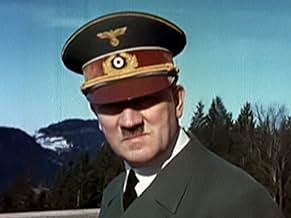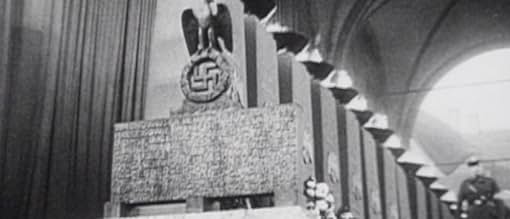अपनी भाषा में प्लॉट जोड़ेंThe Nazification of Germany from 1933 to 1945 told through a compilation of Nazi footage, newsreels, propaganda films and Eva Braun's home movies.The Nazification of Germany from 1933 to 1945 told through a compilation of Nazi footage, newsreels, propaganda films and Eva Braun's home movies.The Nazification of Germany from 1933 to 1945 told through a compilation of Nazi footage, newsreels, propaganda films and Eva Braun's home movies.
Galeazzo Ciano
- Self
- (आर्काइव फ़ूटेज)
Albert Einstein
- Self
- (आर्काइव फ़ूटेज)
Joseph Goebbels
- Self
- (आर्काइव फ़ूटेज)
- (as Josef Goebbels)
Hermann Göring
- Self
- (आर्काइव फ़ूटेज)
Heinrich Himmler
- Self
- (आर्काइव फ़ूटेज)
Adolf Hitler
- Self
- (आर्काइव फ़ूटेज)
Benito Mussolini
- Self
- (आर्काइव फ़ूटेज)
Jesse Owens
- Self
- (आर्काइव फ़ूटेज)
Joachim von Ribbentrop
- Self
- (आर्काइव फ़ूटेज)
फ़ीचर्ड समीक्षाएं
Nothing really new here for students of history. But for casual observers of world events who are not students of history, it may raise a few eyebrows. Lots of good footage and the Mora does a great job of not including unnecessary narration (the footage is painfully explicit on what happened (if not why it happened). Of course, the Versailles Treaty is not mentioned in detail; a major cause for the rise of Hitler because Germany was burdened with great war reparation debt from that treaty. This mightily led to Hitler's rise. Lesson? Reforming a country that loses a war is better than strangling it to a slow death. Nice home movie footage as well which tries to humanize Hitler. Good luck with that idea.
Because this documentary is centered on a place almost universally reviled by everyone on Earth, it was surprising to see it start off with quite a controversial statement. The opening slide states that if future historians demonize Hitler because of what he did, they're going to miss the entire point of the film, as it shows (largely through his eyes) what he really was: a human. This film, while basically just a large assortment of newsreels and footage from prewar Nazi Germany, surprised me more than a few times. With the Second World War being the historical subject I devote the most time to learning about, I wasn't expecting this movie to contain things I have never seen before. Most will be familiar with things like the huge rally in Nuremberg, as well as Neville Chamberlain professing to the British public Hitler won't fight England just because he signed a meaningless agreement. However, there's also scenes of propaganda minister Dr. Goebbels visiting Hitler at his mountain house in southern Bavaria. These types of clips tend to humanize Hitler and make him seem almost normal, which is probably why most people haven't seen them. I really did not expect to see Eva Braun saying how handsome she thinks Clark Gable is either. Her home movies taken at the Obersalzberg have been in countless ww2 documentaries, including what is probably the best one ever (World at War), but they never fail to be eerie to watch. We see her and her sister Gretl swim in a river, and later, she brings her scottish terriers to Hitler's house. Adolf reportedly didn't like Eva's dogs because they bit Blondi, his german shepherd. Ironically, one of her dogs was named Stasi, which would be the name of the postwar secret police in communist east germany. Another thing that caught my attention was taking a look inside the Reich Chancellery, which was the building Hitler commanded germany from. Aside from his office, pretty much the whole entire interior of the building looks like a 5 star hotel. Also shown is an art museum containing the works of National Socialist painters and sculptors, both trying their hardest to capture the perfect likeness of the Nordic race. One of Mussolini's in-laws is present at the opening ceremony. The statues in the museum are quite impressive, given that they were made in the 30s. One consisting of a man and his horse makes even Michaelangelo's David look tiny. The film includes some things that aren't really related to nazism, but were thrown in anyway simply because they occurred in germany. One of these is Einstein talking to an audience after he has learned the nazis want him out of germany. It never crossed my mind, but I think this is the first time I heard him talk. The documentary doesn't go into world war 2 itself, and only focuses on the period from 1933 to 39, but does jump ahead to 1945 at the end. This means it's nowhere near as comprehensive as something like World at War, which not only includes much of the same footage but also includes interviews with people who were within 5 feet of Hitler for much of his time as chancellor. While the footage of the 1936 Olympics, home movies and other things are enough to make the film passable in my eyes, it is hampered by a lack of substance to stand on. The footage is the only thing here telling the story. As a consequence, this will probably only please avid fans of this type of history, but it wasn't a problem for me. There's definitely a lot of things I never saw before, so it's excusable.
In the 1970s, historian Lutz Becker discovered a singular contemporary document: the so called "Home Videos" of Eva Braun. The 16 mm images show Adolf Hitler and his entourage in his country home Berghof at Obersalzberg. Becker turned to the young director Philippe Mora, who arranged the Home Videos with other footage from Germany in the 30s. The result was an unusual documentary: "Swastika". It premiered in 1973 at Cannes, where it caused a scandal. The movie had to be stopped halfway through, because the audience was irritated by the seemingly trivializing depiction of Hitler. In France, the movie role was stolen from a cinema and spread over the graves of Jewish Holocaust victims.
As you can see, "Swastika" was political dynamite. It was one major decision by Philippe Mora that caused all the fuss: He renounced every didactic commentary. There is no voice-over contextualizing the footage. Whoever watches this movie has to establish the critical distance alone. We have to find our own way through the propaganda Mora confronts us with. That makes for a challenging, captivating experience. The movie isn't completely neutral, though. There might be no verbal commentary, but there certainly is a stylistic one. For instance, in one scene we see Hitler taking a walk with a small girl, where Mora cuts repeatedly to pauperized ghetto children. Interestingly, these direct condemnations form the weakest parts of "Swastika". The movie is at its best when it just shows us the German delirium that was the Third Reich: cheering crowds, swastikas everywhere, sappy art, orotundity à la Riefenstahl, and finally Hitler presenting himself as a cool-headed and insightful leader. This madness ought to be a punch in the gut of every (reflected) viewer.
Then there are the color movies that Eva Braun recorded at Obersalzberg. We see a middle-class community enjoying itself, all while the Holocaust is raging. Among them: Hitler the personified evil, shown in all his banality. He's shockingly boring, standing around clumsily, almost dim-witted; talking about the Hollywood classic "Gone With the Wind", pondering the future of technicolor and playing with his dog Blondi. What do these images want to show us? What can they show us? The answer is: not much. At least nothing we shouldn't have known in the first place. Hitler wasn't some kind of monstrosity that came from outer space. He was a human like all of us. If we dehumanize him, we will never understand the catastrophe that was Word War II - insofar it is understandable at all. That's a simple yet important message the movie tells us rather clumsily at times. But "Swastika" shouldn't be reduced to that basic thesis. It shows more than it tells.
The juxtaposition of image and sound is especially remarkable. The love song "What Wouldn't I Do for That Man" ironically characterizes not only the relationship between Hitler and Eva Braun, but also the Hitler cult of the Germans. The use of Noël Coward's satirical song "Don't Let's Be Beastly To The Germans" after devastating pictures of mass extermination is downright cynical.
To this day, "Swastika" is a brave documentary that omits instruction (almost) entirely. The execution is a bit shaky, but you can't deny the unsettling atmosphere Mora's editing creates.
As you can see, "Swastika" was political dynamite. It was one major decision by Philippe Mora that caused all the fuss: He renounced every didactic commentary. There is no voice-over contextualizing the footage. Whoever watches this movie has to establish the critical distance alone. We have to find our own way through the propaganda Mora confronts us with. That makes for a challenging, captivating experience. The movie isn't completely neutral, though. There might be no verbal commentary, but there certainly is a stylistic one. For instance, in one scene we see Hitler taking a walk with a small girl, where Mora cuts repeatedly to pauperized ghetto children. Interestingly, these direct condemnations form the weakest parts of "Swastika". The movie is at its best when it just shows us the German delirium that was the Third Reich: cheering crowds, swastikas everywhere, sappy art, orotundity à la Riefenstahl, and finally Hitler presenting himself as a cool-headed and insightful leader. This madness ought to be a punch in the gut of every (reflected) viewer.
Then there are the color movies that Eva Braun recorded at Obersalzberg. We see a middle-class community enjoying itself, all while the Holocaust is raging. Among them: Hitler the personified evil, shown in all his banality. He's shockingly boring, standing around clumsily, almost dim-witted; talking about the Hollywood classic "Gone With the Wind", pondering the future of technicolor and playing with his dog Blondi. What do these images want to show us? What can they show us? The answer is: not much. At least nothing we shouldn't have known in the first place. Hitler wasn't some kind of monstrosity that came from outer space. He was a human like all of us. If we dehumanize him, we will never understand the catastrophe that was Word War II - insofar it is understandable at all. That's a simple yet important message the movie tells us rather clumsily at times. But "Swastika" shouldn't be reduced to that basic thesis. It shows more than it tells.
The juxtaposition of image and sound is especially remarkable. The love song "What Wouldn't I Do for That Man" ironically characterizes not only the relationship between Hitler and Eva Braun, but also the Hitler cult of the Germans. The use of Noël Coward's satirical song "Don't Let's Be Beastly To The Germans" after devastating pictures of mass extermination is downright cynical.
To this day, "Swastika" is a brave documentary that omits instruction (almost) entirely. The execution is a bit shaky, but you can't deny the unsettling atmosphere Mora's editing creates.
This film consists entirely of footage taken during the Third Reich, without the usual background comment. Some is official and mostly in B&W; speeches by Hitler and his henchmen, Nazi celebrations and rituals, the 1936 Olympics, ordinary Germans going into ecstasies over the view of the Führer, exhibitions of awful Nazi "art" and so on. The rest is mainly in color, home movies taken by Eva Braun and others (using an 8mm camera gifted by Hitler) featuring members of Hitler's inner circle plus assorted visitors in his Obersalzberg mountain retreat and environs. I believe this latter footage was made public by the first time in this film, which was shown at the Cannes festival in 1973.
The movie's purpose is clearly stated on the first screen: "If the human features of Hitler are lacking in the image of him that is passed on to posterity, if he is dehumanized and shown only as a devil, any future Hitler may not be recognized simply because he is a human being." Indeed Hitler was not an abstraction like a "devil" or "monster," but a human being, albeit one capable of almost inconceivable levels of evil. This take on Nazism was controversial, aroused violent responses at Cannes and the film was banned for many years in Israel and Germany. Since then, the home movie footage has been featured in many documentaries and is available in You Tube.
The last shots are of German cities razed to the ground and one particularly horrifying sequence filmed in the recently liberated Belsen concentration camp, with Noel Coward's wartime satyrical song "Don't let's be beastly to the Germans" as background music.
In some of the home movies shown, snatches of dialogue (mostly unintelligible) are heard. Since the original footage was soundless, the dialogues were reconstructed. We don't know how or from what sources. Much later (in 2006) the conversations were almost entirely restored using sophisticated lip reading software. This footage can be seen in Hitler's Private World, a 2006 episode of the British TV series Revealed.
The movie's purpose is clearly stated on the first screen: "If the human features of Hitler are lacking in the image of him that is passed on to posterity, if he is dehumanized and shown only as a devil, any future Hitler may not be recognized simply because he is a human being." Indeed Hitler was not an abstraction like a "devil" or "monster," but a human being, albeit one capable of almost inconceivable levels of evil. This take on Nazism was controversial, aroused violent responses at Cannes and the film was banned for many years in Israel and Germany. Since then, the home movie footage has been featured in many documentaries and is available in You Tube.
The last shots are of German cities razed to the ground and one particularly horrifying sequence filmed in the recently liberated Belsen concentration camp, with Noel Coward's wartime satyrical song "Don't let's be beastly to the Germans" as background music.
In some of the home movies shown, snatches of dialogue (mostly unintelligible) are heard. Since the original footage was soundless, the dialogues were reconstructed. We don't know how or from what sources. Much later (in 2006) the conversations were almost entirely restored using sophisticated lip reading software. This footage can be seen in Hitler's Private World, a 2006 episode of the British TV series Revealed.
I tripped over this movie late at night on Amazon on-demand video. I gotta tell you, it's definitely interesting. It shows the "human" side of Hitler, joking around with staff, making wise cracks here and there, complaining about cigarette smoke, etc. I think the intent of the story (which is basically newsreel and personal movie camera footage in order from 1935 to 1945) is to chronicle the rise and fall of Hitler, as seen in his eyes. You can see how the war wears on him- he gets grayer, starts shaking at times, and even see how he can't stand being in direct sunlight because of the drugs he was on. So, knowing his personal and physical history from what I've read before about the sick Bastard, this movie confirms those conclusions (i.e.- he was mentally ill and took large doses of drugs that blurred his speech, the way he walked, the way he interacted with others, etc. So, it's a good documentary from that end. Suggest watching with the volume down most of the time because hearing all the "Hiel Hitler!"s are enough to make you want to drink...
क्या आपको पता है
- ट्रिवियाThe provocative documentary was banned in Israel on the ground that it projects a sympathetic image of Adolf Hitler.
- कनेक्शनFeatured in Krauts and Doubts: Swastika Revisited (2006)
टॉप पसंद
रेटिंग देने के लिए साइन-इन करें और वैयक्तिकृत सुझावों के लिए वॉचलिस्ट करें
- How long is Swastika?Alexa द्वारा संचालित
विवरण
- रिलीज़ की तारीख़
- कंट्री ऑफ़ ओरिजिन
- आधिकारिक साइट
- भाषा
- इस रूप में भी जाना जाता है
- Swastika - hakkorset
- उत्पादन कंपनी
- IMDbPro पर और कंपनी क्रेडिट देखें
- चलने की अवधि1 घंटा 53 मिनट
- रंग
- ध्वनि मिश्रण
इस पेज में योगदान दें
किसी बदलाव का सुझाव दें या अनुपलब्ध कॉन्टेंट जोड़ें




























